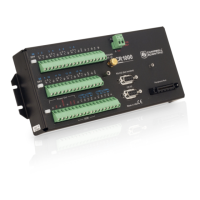Measurement Accuracy Example
The following example illustrates the effect percent-of-reading and offset have on
measurement accuracy. The effect of offset is usually negligible on large signals:
Example:
• Sensor-signal voltage: ≈2500 mV
• CRBasic measurement instruction: VoltDiff()
• Programmed input-voltage range (Range): mV2500 (±2500 mV)
• Input measurement reversal (RevDiff): True
• CR1000 circuitry temperature: 10 °C
Accuracy of the measurement is calculated as follows:
accuracy = percent-of-reading + offset
where
percent-of-reading = 2500 mV • ±0.06%
= ±1.5 mV
and
offset = (1.5 • 667 µV) + 1 µV
= 1.00 mV
Therefore,
accuracy = ±1.5 mV + 1.00 mV
= ±2.5 mV
Integration
The CR1000 incorporates circuitry to perform an analog integration on voltages to
be measured prior to the A-to-D
(p. 507) conversion. Integrating the the analog
signal removes noise that creates error in the measurement. Slow integration
removes more noise than fast integration. When the duration of the integration
matches the duration of one cycle of ac power mains noise, that noise is filtered
out. The table Analog Measurement Integration
(p. 316) lists valid integration
duration arguments.
Faster integration may be preferred to achieve the following objectives:
• Minimize time skew between successive measurements
• Maximize throughput rate
• Maximize life of the CR1000 power supply
• Minimize polarization of polar sensors such as those for measuring
conductivity, soil moisture, or leaf wetness. Polarization may cause
measurement errors or sensor degradation.
• Improve accuracy of an LVDT measurement. The induced voltage in an
LVDT decays with time as current in the primary coil shifts from the inductor
to the series resistance; a long integration may result in most of signal
decaying before the measurement is complete.
Read More See White Paper "Preventing and Attacking Measurement Noise
Problems" at www.campbellsci.com.
315

